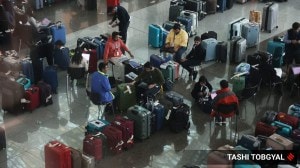A city hostage to votes
Let us face it. Mumbai has hit its maximum capacity to accommodate people, both in terms of land and funds. The Congress needs to think care...

Let us face it. Mumbai has hit its maximum capacity to accommodate people, both in terms of land and funds.
The Congress needs to think carefully now. The first census of hutments was done around 1976-77 and the idea was that these hutment dwellers would be given photo passes and rehabilitated properly. But this deadline has been repeatedly extended and now stands at 1995. There is no guarantee that in the next general election manifesto, this deadline will not be further extended until 2005.
If this tendency is not checked, Mumbai will become a vast slum.
It is therefore absolutely necessary that in the interest of Mumbai’s existence, as also its economic development, this is not allowed to happen. Removing illegal hutments is the only way that further growth of unauthorised hutments can be stopped and more migrants expecting free housing can be discouraged from coming to Mumbai.
Statements issued by various parties merely indicate that instead of welfare of the hutment dweller, they are more concerned about the political fallout which would affect their fortunes. This is a most cynical attitude and deserves to be condemned thoroughly.
But what has happened is not really a demolition. The Chief Minister said, quite clearly, that these are illegal encroachments being cleared. In any case, call it what you like, but the fact remains that these are all illegal encroachers. Tomorrow if somebody sees bread in a shop, decides to just take it and then says he really needed it so he should not be prosecuted…You have to draw the line somewhere.
My own opinion is that as the law says those before 1995 should be protected, these people should be rehabilitated. If somebody breaks the law, you have to treat it as any other offence.
As for human rights violations during the drive, perhaps these things could have been better planned. But remember that this is theft of government land.
Of course, the poor people who are suffering have been misled by slumlords. Many of them have come from Bihar, Uttar Pradesh and rural parts of Maharashtra. They’ve been told here’s land for you. Some have even paid for the little pieces of land they live on.
The government should get hold of all those people responsible for building slums, as well as all those officials—civic and police—who allowed this crime to be committed. In fact, in Johannesburg, there’s a law that says any unauthorised construction should be dealt with within 48 hours.
Coming to rehabilitation, we are all in favour of proper rehabilitation of pre-1995 hutments and would urge the Central Government to give adequate funds to the state government to carry on these programmes of rehabilitation.
As for those additional lakhs who who will now have to be rehabilitated—those who built their huts between 1995 and 2000—there is no question of rehabilitating them in the island city. There’s simply no space.
But there’s no reason why they cannot be rehoused just outside the city. We’ve been talking to the former mayor of Johannesburg, which faced a similar problem of unchecked slums some years ago. Those people have now been rehabilitated 30-35 km outside the city. We should attempt something similar, providing adequate services—transport, sanitation, water…
Personally I think the extension of protection to all pre-2000 slum-dwellers should not have happened. However, the Chief Minister has made it clear that these people will have to pay.
But it’s sad. We’ll have another election; will they then extend the date to 2010?
But there are definitely ideas on where to rehabilitate those affected by the current drive. The Vision Mumbai document, aiming to create a world-class city, had suggested—15 months ago—that 1.1 million low-income houses should be built. Had they been built by now, those evicted recently could have been shifted there.
Other things that Vision Mumbai touches upon are transportation—we’re still moving 21st-century traffic on 19th-century infrastructure. We want to improve east-west connectivity in a linear city, the airport, the water supply system (in some parts of the city, you get water for a mere four hours a day), proper sanitation…
In some areas, people are living in the way of roads to be widened. In other areas, people are squatting on top of water pipelines. There are 800 acres of unused land lying with the port trust. That could be developed in the style of the London dockyard. Low-income houses can be built there, as well as recreation grounds.
The proposed trans-harbour freeway will open up immense opportunity across the harbour too. There’s plenty of land there, also cheap. Slum-dwellers can pay—and many are willing to pay too—for accommodation there.
Then there’s the 300 acres of mill land, waiting to be developed in a systematic way. One-third must be reserved for housing for the poor, for labourers. The other two-thirds can be shared between the owner and reservations for open spaces.
The city is choking, everybody knows. More gardens, open spaces are also essential while developing Mumbai. What has happened is that almost 90 per cent is exploited for commercial purposes. I definitely oppose that. Mumbai will never again get such a golden opportunity. If you follow the original government formula, there’s considerable land available for open spaces—where the government can build parks, playgrounds.
There’s some opposition to the ‘Mumbai-Shanghai’ dream. But Shanghai is only a model. Shanghai has shown in the last 10 years that a road with no good roads and several slums can also transform itself. We need not be exactly like them, but they have proven that a transformation is possible.
We support the Chief Minister—he’s shown bold initiative and is doing great work to transform a decaying city into a world-class city.
The writer is chairman of Bombay First group and member of Citizens’ Action Forum. This account was told to Kavitha Iyer
- 01
- 02
- 03
- 04
- 05































